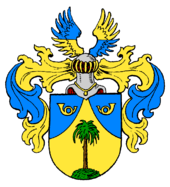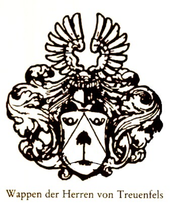Treuenfels (noble family)
Treuenfels is the name of a Mecklenburg - Prussian noble family . The family currently continues.
There is no regular relationship to Carl Bernhard Brodorotti of Treuenfels, 1808 ennobled was. The Bidembach von Treuenfels that passed away or the Baden weavers from Treuenfels are also not related.
history
The postal inspector Johann Cannolt was raised to the Swedish nobility on November 4, 1689 with the title of nobility von Treuenfels . Johann Leopold Hedt was also ennobled in 1723 with the same coat of arms and predicate.
The Cannolt family originally came from Lausitz . Postmaster Johann Cannolt was appointed by the Swedish King Karl XI. ennobled for the loyalty he had shown him during the brief occupation of Wismar by the Danes during the Thirty Years' War. In the name, as with similar families of a new post-aristocratic class in Sweden and Denmark, the relationship to the ruling house should be documented.
Mecklenburg
Since the end of the 17th century the family can be traced back to Mecklenburg. The brothers Wilhelm Vollrath von Treuenfels on Möllenbeck , Artur Hugo von Treuenfels on Benz and chamberlain Carl Ludwig Casper von Treuenfels on Neuhof were accepted into the Mecklenburg knighthood in 1862 .
Wilhelm Vollrath August von Treuenfels (1821–1900) had been married to Marie Rosalie von Hartmann (1832–1865) since 1851. The marriage resulted in two sons and a daughter. In 1871 he bought the Lenschow estate from Friedrich Karl Albrecht von Maltzan . In 1885 he bought Gut Muschwitz with Neu Herzberg von Ratzscher and in 1890 the Gut Herzberg from Friedrich Ernst August Hellmuth von Maltzan. Wilhelm Vollrath August von Treuenfels passed the goods Lenschow (500 hectares), Herzberg (810 hectares) and Muschwitz (370 hectares) to his first-born son Wilhelm Karl Arthur Albrecht (1852-1945). He married Luise Kordula Caroline Luci von Zepelin (1856–1948) on January 29, 1879 . The marriage also resulted in two sons and a daughter. He also handed over the goods to his first-born son Hermann Ernst Wilhelm. Wilhelm Karl Arthur Albrecht von Treuenfels did not flee from the Russians in 1945 and died shortly after the end of the war on June 4, 1945 in Lenschow.
In the registration book of the Dobbertin monastery there is a registration with the number 1834 for Marie Luise von Treuenfels, daughter of Captain Wilhelm Karl Arthur Albrecht von Treuenfels auf Lenschow from the Neuhof house on December 6, 1891. The registration fee was paid back because Marie on November 15, 1912 in Schwerin Friedrich Freiherr von Maltzan von Wartenberg and Penzlin married. She died on January 31, 1920 in Damerow.
Son Hermann Ernst Wilhelm von Treuenfels (1879–1965) was married to Ehrengard Franziska von Maltzan (1890–1981) since 1911. From this marriage four sons were born. Three of the four sons, including the firstborn, died in Russia and Italy during World War II . Hermann Ernst Wilhelm von Treuenfels served himself up to lieutenant colonel during the First World War . Shortly before the end of the war in 1945 and the arrival of the Red Army in the Goldberg , Mestlin and Herzberg area, Hermann von Treuenfels fled with his wife and his son, Ehrenfried Mortimer (1916–1991), to what would later become the British occupation zone . All three lived in Mölln until their death and were buried there.
From 1920, Martin Bormann (1900–1945), who later became the Reichsleiter and private secretary of Adolf Hitler , completed an agricultural training as an estate manager at Hermann von Treuenfels' Herzberger Gut. There Bormann worked in the traditional association of the former Freikorps Roßbach as a section head of the organization. In 1924 he served a one-year prison sentence for aiding and abetting in the murder of Walter Kadow (1900-1923), the so-called Parchimer Fememord . The young communist from Hagenow, Walter Kadow, also worked on the estate in Herzberg and wanted to join the ranks of the Rossbach people. After Bormann said the traitor must go , he was murdered on May 31, 1923 in the forest near Neuhof west of Parchim by Rudolf Höß , who later became the camp commandant of Auschwitz .
Trivia
In Herzberg people were told how hard and unyielding Mr. von Treuenfels raised his children. His two sons had ponies in good time to learn to ride. The first big ride took place on a Sunday. We went across the fields towards Mühlenhof . In the lead, Herr von Treuenfels rode his stallion, followed one after the other on the ponies by the two boys. Then they should jump over the Warnowgraben , but the ponies defied the unfamiliar obstacle. On the second attempt, Herr von Treuenfels gave the whip and the jump succeeded, but the boys fell into the water. Furious, Herr von Treuenfels trotted back with the ponies in the direction of Herzberg, without even looking at his clumsy sons.
A fictional Harro Graf von Treuenfels is one of the main characters in Hedwig Courths-Mahler's novel Griseldis , published in 1917 .
Historical property
Real estate existed in Mecklenburg and Ostprignitz.
- 1694-1756 Golchen
- 1730–1945 Benz and Briest
- 1758 Neuhof near Zarrentin
- since 1819 Oldendorf and Horst (Lauenburg)
- 1830 Repzin
- 1829–1945 Möllenbeck near Ludwigslust with Vorwerke Horst and Carlshof
- 1871 Lenschow
- 1872–1945 Klenz
- 1784–1945 New Damerow
- 1885–1945 Muschwitz with Neu Herzberg , from 1980 desolate , ie demolished.
- 1890–1945 Herzberg
- 1904–1926 Diestelow
coat of arms
The coat of arms (1689, 1735) shows in blue a rising golden tip accompanied by two inwardly turned golden post horns , inside a natural palm tree on a green hill . On the (blue-gold bulged ) helmet with blue-gold helmet covers, an open flight divided by blue and gold across the corner .
Relatives
- Moritz von Treuenfels (* 1988), film and theater actor
- Johann von Treuenfels (1630–1706), Swedish postal inspector at the tribunal in Wismar , heir to Golchen
- Anna-Elisabeth von Treuenfels (* 1962), member of the state parliament (FDP)
- Carl von Treuenfels (1863–1931), landowner and member of the German Reichstag
- Carl-Albrecht von Treuenfels (* 1938), German author, photographer, publicist and conservationist
- Wilhelm Karl von Treuenfels (1740–1813), Prussian lieutenant general
literature
-
Genealogical manual of the nobility , CA Starke Verlag , Limburg (Lahn), ISSN 0435-2408
- Adelslexikon , Volume XV, Volume 134 of the complete series, 2004, pp. 12-13
- Genealogical handbook of noble houses , B 5, Volume 26 of the complete series, 1961, pp. 417-422; B 21, volume 108 of the complete series, 1995, pp. 532-542
- Gothaisches Genealogisches Taschenbuch der Areligen Häuser B, Justus Perthes , Gotha 1920 (older history), 1922, 1928, 1935 (stem series), 1939
- Ernst Heinrich Kneschke : New general German nobility lexicon . Leipzig 1870, Volume 9, p. 269
- Leopold von Ledebur : Nobility Lexicon of the Prussian Monarchy . Volume 3, Berlin 1858, p. 27
- Gustav von Lehsten: The nobility of Mecklenburg since the constitutional hereditary comparisons (1755). Rostock 1864, pp. 270-271
- Ulrich von Oeynhusen: History of the von Treuenfels'schen knighthood Benz, Office Schwerin. Schwerin 1906
- von Pentz: Contributions to the history of the family v. Treuenfels , 1932
-
Sieve maker
- III.06. Mecklenburg, p. 20, Tfl. 19th
- III.02.I. Prussia, p. 417, Tfl. 461
- Leopold von Zedlitz-Neukirch : New Prussian Adelslexicon . Leipzig 1837, Volume 4, p. 274 ; 1839, Vol. 5, pp. 446-447
Web links
Individual evidence
- ↑ Other unrelated families are the Hauschka von Treuenfels (see: Wiener genealogisches Taschenbuch , Volume 8, 1937, pp. 76-80), the Hülsen von Treuenfels (see: Bernhard von Poten : The Generals of the Royal Hanoverian Army and their originating troops . ES Mittler & Sohn , Berlin 1903, p 252) and the Standeisky of Treuenfels (cf .: Genealogical Handbook of the nobility , Adelslexikon, Vol. 14, 2003, p 17).
- ^ Horst Alsleben : Alphabetical directory for the Dobbertiner registration book. Schwerin 2012.
- ^ Ralph Martini: Auschwitz trace to Mecklenburg. Schweriner Blitz am Sonntag, No. 4, January 26, 2014.
- ↑ Burghard Keuthe: Parchimer say. 1993, pp. 53-54.
- ^ Gottlieb Matthias Carl Masch : Mecklenburgisches Wappenbuch. Rostock 1837, No. 189.
- ^ Genealogisches Handbuch des Adels , Adelslexikon (lit.).

